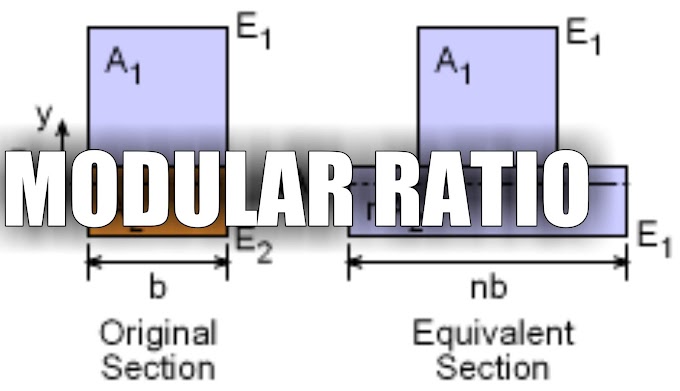Overlay Design for Rigid Pavements
Step 1: Pavement Condition Survey
Perform visual inspection and non-destructive testing to assess the condition of the pavement.
Step 2: Data Collection
Collect data such as historical construction details, traffic loads, and axle load surveys.
Step 3: Deflection Analysis Using Falling Weight Deflectometer (FWD)
Perform FWD tests at radial distances to collect deflection data for various points. The following formulas are used:
Area Parameter (A) of the Deflection Basin
\[ A = 6 \left( \frac{D_1}{D_0} + \frac{D_2}{D_0} + \frac{D_3}{D_0} \right) \]
Where:
A= Area parameter of the deflection basinD_0= Deflection at the center of the loading plate (0 mm from the center)D_1= Deflection at 300 mm from the centerD_2= Deflection at 600 mm from the centerD_3= Deflection at 900 mm from the center
Radius of Relative Stiffness (l)
The radius of relative stiffness (l) can be evaluated from charts in the guidelines.
Step 4: Evaluation of Pavement Distresses
Modulus of Subgrade Reaction (k-value)
\[ k_i = \frac{P \cdot l^2}{D_i} \]
Where:
k_i= Modulus of subgrade reaction (MPa/m)P= Load applied (kN)l= Radius of relative stiffness (mm)D_i= Measured deflections at various radial distances
Elastic Modulus of Concrete (Ec)
\[ E_c = \frac{12 \cdot (1 - \mu_c^2) \cdot k \cdot l^3}{h^3} \]
Where:
E_c= Elastic modulus of concrete (MPa)\mu_c= Poisson's ratio of concretek= Modulus of subgrade reaction (MPa/m)l= Radius of relative stiffness (mm)h= Thickness of concrete layer (mm)
Compressive Strength of Concrete (fc)
\[ f_c = \left( \frac{E_c}{5000} \right)^{0.5} \]
Flexural Strength of Concrete (fmr)
\[ f_{mr} = 0.7 \cdot (f_c)^{0.5} \]
Step 5: Calculation of Remaining Life (Fatigue Life)
To calculate the fatigue life, use the following equation from IRC:58-2011:
\[ N = 4.2577 \cdot 10^3 \cdot \left( \frac{1}{SR^{3.268}} \right) \quad \text{for} \ 0.45 \leq SR \leq 0.55 \]
or
\[ \log N = 0.9718 - 0.0828 \cdot SR \quad \text{for} \ SR > 0.55 \]
Cumulative Fatigue Damage (CFD)
\[ CFD = \sum \frac{n_i}{N_i} \]
Step 6: Design of Overlay
The overlay thickness is determined based on traffic loads, remaining life, and pavement distress calculations.
Step 7: Rehabilitation of Joints and Cracks
Filling of Voids
Voids are filled using cement grout.
Load Transfer Efficiency (LTE)
Load transfer efficiency at joints is calculated using the following formula:
\[ LTE = 100 \cdot \left( \frac{D_2}{D_1} \right) \]
Step 8: Final Overlay Placement
After repairs, the overlay is placed (either concrete or asphalt).
Step 9: Post-Construction Monitoring
Periodic monitoring of the overlay is essential.




0 Comments